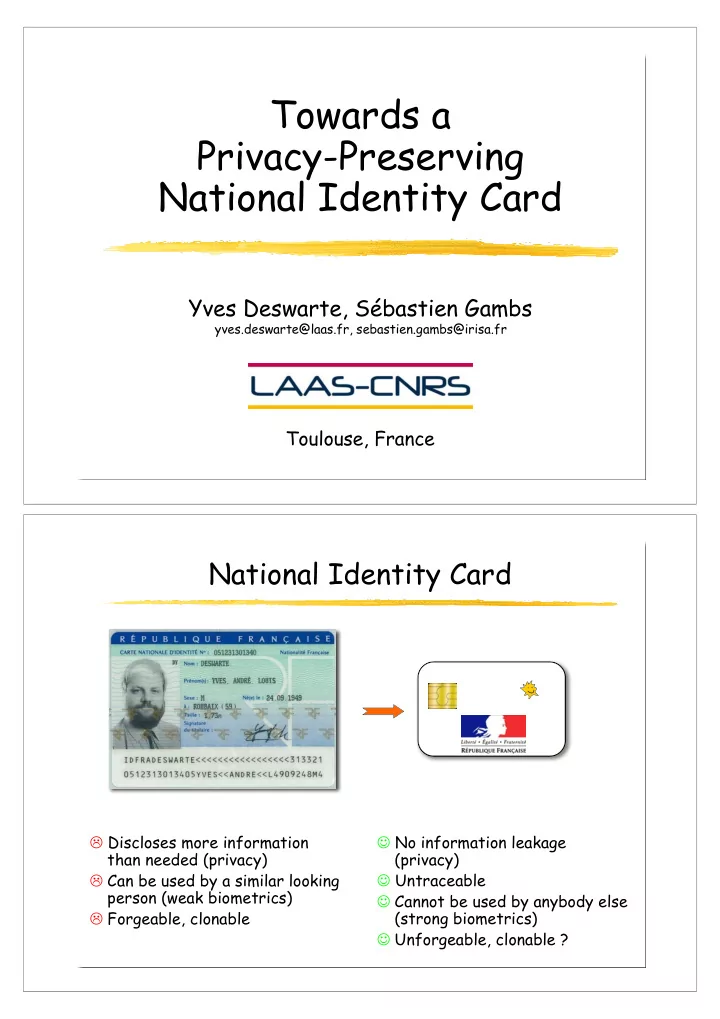

Towards a Privacy-Preserving National Identity Card Yves Deswarte, Sébastien Gambs yves.deswarte@laas.fr, sebastien.gambs@irisa.fr Toulouse, France National Identity Card ! Discloses more information " No information leakage than needed (privacy) (privacy) ! Can be used by a similar looking " Untraceable person (weak biometrics) " Cannot be used by anybody else ! Forgeable, clonable (strong biometrics) " Unforgeable, clonable ?
Current Electronic ID cards w.r.t. traditional cards: # More secure (tamper-resistant chip) o Difficult to forge o Protection against identity stealing if using stronger biometrics (e.g., fingerprint) # … but more privacy intrusive (online use) o Readable identity information o Risk of abuse --> tracing, information crossing ex. e-administration, e-commerce, … What an Id Card is used for ? # Proof of Nationality e.g. border control # Proof that a document is valid for a person e.g. credit card, bank check, boarding pass, … # Proof of rights e.g. senior citizen, free access to a local library, swimming pool… # Proof of identity for sensitive registration (liability) e.g. bank account, new business, … # Proof of not being on a wanted person list e.g. police control, … # … and many abusing usage : e.g. monitoring, tracing, information crossing, marketing, …
Using a Privacy-Preserving ID Card # The card is issued by an authority (e.g., local government) the chip is supposed to be tamperproof (confidentiality, integrity) # The chip contains the identity information + biometry template # Contact card (no risk of RFID skimming, owner’s consent) # Mutual authentication between chip $ and (certified) reader % with unlinkability (there is no ID card number !) # User authentication through biometry scan & o By the card ( fingerprint ) or by the reader ( fingerprint , iris , voice , …) o Biometric templates stored and verified by the chip # Basic principles: o The stored information never leaves the chip o Questions are asked to the chip ' (according to reader’s clearance ), the replies are only binary : yes or no ( P-P ID Card use # Nationality proof : o Reply = YES (as soon as biometry verification & ) # Identity verification (e.g. boarding pass, bank check…) : o Question : Name & First Name = “Doe, John” ? o Reply : YES or NO # Vicinity verification : city, county, state, … (e.g., free access to library) o Question : Home Town = “Saint Malo” ? o Reply : YES or NO # Majority verification, senior citizenship, … o Question : today = 09/24/2009; age ! 18 ? o Reply : YES or NO # Police control (e.g. wanted people) o Question : Name & First Name = “Bin Laden, Usama” ? o Reply : NO
Hardware Technologies # Smartcard reader + biometry : Software & algorithms # PK Certificate o Reader authentication # Group signature o Card authentication # Fuzzy commitment o Biometry verification # Secure channel (between card and reader) o Reader public key, card-generated session public key o Semantically secure binary reply # To relax tamperproof requirement : o Biometry verification: fuzzy extractor --> decrypt stored data o Non-interactive zero-knowledge proofs of statements
Group Signature Ks(1) n signature Kv generation keys (secret) Ks(n) 1 signature verification key (public) Challenge = random number ! = {Challenge} Ks(i) [ ! ] Kv = ? = Challenge Fuzzy Commitment / Extraction # Biometry scan (sent to the chip) “1100101011000110110101010…101010010111100101011011011” # Transformation : ECC encoding “01101001001110001011010011” # Error Correction --> Closest Code word “01111000101110011011010010” # Is it equal to the stored template ? Yes/No
Extensions (1) # Biometric sensor + display on the smartcard itself o Better trustworthiness ? o Other uses: e.g., display the owner’s picture, display the question, … Extensions (2) # Remote identity proofs o e-Administration: income tax declaration, official document printing, … o e-Voting o e-Commerce, … # Problems o Limits of unsupervised biometry ? o Phishing with stolen reader ?
Extensions (3) # Integrate the ID card into a cell phone o Wireless connection (NFC, Bluetooth, WiFi, 3G) o Biometry through phone sensors (voice, iris) o More capability on the user side (e.g., display, audit log) # Problems o Trustworthiness of the phone ? o More risks of linkability (IMEI, MAC@, …) Conclusion # Users can be confident that this card disclose as little information as possible # It is more secure than current cards o Cannot be used, except by the owner --> low risk of stealing --> no need for revocation --> no burden for recreation # The technology exists today # Would it be adopted by states ?
More information # Extended version at http://hal.archives-ouvertes.fr/hal-00411838/fr/ # Mailto: deswarte@laas.fr
Recommend
More recommend